Future Combat Systems Manned Ground Vehicles
The Future Combat Systems Manned Ground Vehicles (MGV) was a family of lighter and more transportable ground vehicles developed by BAE Systems Inc and General Dynamics as part of the United States Army's Future Combat Systems (FCS) program. The ground vehicles were to be based on a common tracked vehicle chassis.[1] The MGV program was superseded by the Ground Combat Vehicle which has also been cancelled.
| FCS Manned Ground Vehicles | |
|---|---|
 XM1202 Mounted Combat System vehicle illustration | |
| Type | Tracked armored fighting vehicles |
| Place of origin | United States of America |
| Specifications | |
| Crew | Varies from 2–4 depending on vehicle |
Main armament | Most vehicles armed with a cannon |
Secondary armament | Most vehicles armed with a machine gun |
History
In May 2000 DARPA awarded four contracts to four industry teams to develop Future Combat Systems designs and in March 2002, the Army chose Boeing and Science Applications International Corporation (SAIC) to serve as the "lead systems integrators" to oversee the development and eventual production of the FCS’ 18 systems.[2] In October 2002 United Defense (UD) and Boeing/SAIC signed a memorandum of understanding to bring the Objective Force Non-Line-of-Sight Cannon under the FCS umbrella.[3]
In May 2003 the Defense Acquisition Board (DAB) approved the FCS’ next acquisition phase and in August 2004 Boeing and SAIC awarded contracts to 21 companies to design and build its various platforms and hardware and software.[2]
In 2005 the army relented on the vehicle's requirement for roll-off C-130 transportability. Relaxing the C-130 requirement to allow vehicles to be transported in a stripped down configuration allowed the weight cap to be increased from 18 tons per vehicle, to 24 tons.[4]
The Department of Defense announced budget cuts in April 2009,[5] which resulted in the cancellation of the FCS Manned Ground Vehicles family.[6][7] The Army issued a stop-work order for MGV and NLOS-C efforts in June. In July the army terminated the MGV, but not the NLOS-C. In the news release the army said cancelation would "negatively impact" NLOS-C development but said it was seeking a "viable path forward" for the NLOS-C.[8]
The DoD determined that the proposed FCS vehicle designs would not provide sufficient protection against IEDs.[9]
The Army planned to restart from the beginning on manned ground vehicles.[10] The program's heavier successor, the Ground Combat Vehicle, was cancelled in 2014.
Design

Most vehicles were protected with Hard-kill active protection systems capable of defeating most threats.[11] The armor was a unique secret matrix that may be utilized by industry in the Ground Combat Vehicle program.
The common MGV chassis was required to provide full protection from 30 mm and 45 mm cannon fire in a 60 degree arc opening towards the front of the vehicle. 360 degree protection from small arms fire up to 14.5 mm heavy machine gun and 155 mm artillery shell air-bursts was planned. Protection from higher caliber rounds as well as anti-tank guided missiles would be provided by an active protection system manufactured by Raytheon known as "Quick Kill".
Use of a common chassis was to reduce the need for specialized training of personnel and allow for faster fielding of repairs. The MGV platform utilized a hybrid diesel-electric propulsion system. The MGV also employed numerous weight-saving features, including composite armor, composite and titanium structural elements, and continuous band tracks.
The 30-mm Mk44 Bushmaster II chain gun on the reconnaissance and surveillance vehicle and Infantry Carrier Vehicle provided greater firepower but weighed 25% less than the M242 Bushmaster it would replace.[12]
Variants
Initial Technology Demonstrator Vehicle by United Defense yielded both tracked and wheeled prototypes.[13] Only the tracked variant was pursued further.
Wheeled
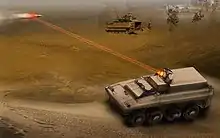
FCS-Wheeled was an early concept designed to demonstrate hybrid-electric drive system and two-man cockpit workstation. A Technology Demonstrator Vehicle was built by United Defense and was unveiled in 2002.
FCS-W was designed to deliver a top road speed of 75 mph and a top cross-country speed of 40 mph. The vehicle's armor utilized armor similar to the tracked variant but was lighter. The vehicle would have also had some type of active protection system. The arrangement of the turbine and drive motor provided for a two-man, side-by-side cockpit and a sizable payload compartment.
Reconnaissance and surveillance vehicle
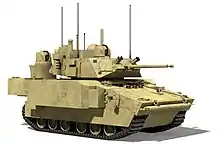
The XM1201 Reconnaissance and Surveillance Vehicle (RSV) featured a suite of advanced sensors to detect, locate, track, classify and automatically identify targets under all climatic conditions, day or night.
The suite included a mast-mounted, long-range optoelectronic infrared sensor, an emitter mapping sensor for radio frequency interception and direction finding, chemical sensor and a multifunction radio frequency sensor.
The RSV also features the onboard capability to conduct automatic target detection, aided target recognition and level-one sensor fusion. To further enhance the scout's capabilities, the RSV is also equipped with Unattended Ground Sensors, a Small Unmanned Ground Vehicle with various payloads and two unmanned aerial vehicles. It is armed with a 30 mm MK44 autocannon and a coaxial 7.62 mm M240 machine gun.
Mounted Combat System

The XM1202 Mounted Combat System was planned as a successor to the M1 Abrams main battle tank.
The Mounted Combat System (MCS) was to provide both direct and Beyond-Line-of-Sight (BLOS) offensive firepower capability, and allowed for in-depth destruction of point targets up to 8 km (5 mi) away. This required the use of an integrated sensor network to detect enemy forces.
As of 2009 the MCS was to have had a crew of two and to be armed with an auto loading 120 mm main gun, a .50 caliber machine gun, and a 40 mm automatic grenade launcher.[14]
The MCS was intended to deliver precision fire at a rapid rate, in order to destroy multiple targets at standoff ranges quickly, and would complement the other systems in the unit of action. It would be capable of providing direct support to the dismounted infantry in an assault, defeating bunkers, and breaching walls during tactical assaults. It was also intended to be highly mobile, in order to maneuver out of contact and into positions of advantage; given the vehicle's light weight, this is especially important.
The XM360 tank gun underwent test firing at Aberdeen Proving Ground beginning in March 2008.[15]
Non-line-of-sight cannon
.jpg.webp)
The XM1203 Non-Line-of-Sight Cannon (NLOS Cannon) was a 155 mm self-propelled howitzer intended to provide improved responsiveness and lethality to the "unit of action" (UA) commander. The NLOSC provided networked, extended-range targeting, and precision attack of point and area targets in support of other combat units with a suite of munitions that include special purpose capabilities. The Non-Line-of-Sight Cannon provided sustained fire for close support and destructive fire for tactical standoff engagement. The NLOS Cannon used technology from the canceled XM2001 Crusader.
It was an 18-ton class vehicle that would have been a replacement for current vehicle systems in the 40-60 ton weight class. It would provide a level of air transportability that current M109 systems cannot at present match.
The system's primary purpose was to provide responsive fire in support of the FCS Combined Arms Battalions (CABs), and their subordinate units in concert with line-of-sight, Beyond-Line-of-Sight (BLOS), Non-Line-of-Sight (NLOS), external and Joint capabilities.
The system as proposed looked to add capabilities that the current M109 systems do not offer. One of the proposed systems advantages was the ability to switch shell types quickly on a one by one basis allowing an illumination round to be followed by a point detonation round, to be followed by an area effect round. This would have given the system the ability to fire different rounds as required by different fire calls or to change types of shells. For instance, destroying a building then engaging anyone fleeing the area with the next round.
The rate of fire in the proposed system would have enabled more rounds sent downrange in a given amount of time, allowing more firepower per system than available with the current M109 system. Another capability offered by the NLOS Cannon was the 'multiple rounds simultaneous impact' (MRSI) mission. A MRSI mission is where the cannon fires several rounds at different trajectories allowing the rounds to impact on the same target at the same time, resulting in little or no reaction time for the enemy to adjust its position. This was accomplished by including the autoloader from the Crusader project which achieved the goals of a much improved fire rate with a reduction in required crew.[16]
The proposed system was envisioned as part of a fast mobile force networked via improved communications and data capabilities to allow rapid response with enhanced accuracy with the view to reducing friendly fire incidents along with lessened collateral damage, while providing superior protective artillery fire to units requiring gunfire support. Navigation of the vehicle and targeting information were provided via GPS and networked information systems.[17]
Improvements in the refueling arrangements and automation of ammunition reloading allowed reduced downtime for logistic functions that would otherwise have left the system unavailable for combat support operations. This also allowed the system to use a crew of two instead of five. This was desirable, as staffing continues to be a major contributor to life cycle cost of any combat system.
The NLOS-C had especially high commonality with the Non-Line-of-Sight Mortar vehicle.
U.S. Senator Jim Inhofe and Chief of Staff of the Army Gen. George W. Casey, Jr. traveled to BAE Systems in Minneapolis, Minnesota in late May 2008 for the rollout of the first Non-Line-of-Sight Cannon prototype. Prototype 1 made its first public appearance on the National Mall in Washington on June 11, 2008. A total of eight prototypes were delivered to the U.S. Army Yuma Proving Ground, Arizona, by 2009.[18] The program was officially cancelled in 2009, along with the rest of FCS.[19]
Non-line-of-sight mortar

The XM1204 Non-Line-of-Sight Mortar (NLOS-M) was a turreted mortar carrier with a four-person crew. It was capable of firing at targets outside of the crew's line of sight (known as indirect fire).
The NLOS-M had a breech-loading, gun-mortar that fired 120 mm munitions including the Precision Guided Mortar Munition (PGMM). It had a fully automated firing control system and a manually assisted, semi-automated ammunition loading system. It uses a crew of 3.
The NLOS-M provides fires on-demand to engage complex and simultaneous target sets. As part of an NLOS-M battery, individual NLOS-M vehicles will provide precision-guided rounds to destroy high-value targets, protective fires to suppress and obscure the enemy, and illumination fires. All of these will be in close support of infantry maneuver units.
The FCS command, control, communications, computers, intelligence, surveillance and reconnaissance (C4ISR) network enables the NLOS-M fire control system to conduct semi- to autonomous computation of technical fire direction, automatic gun lay, preparation of the ammunition for firing, and mortar round firing.
In January 2003 United Defense, now part of BAE Systems, was selected by the Army and the FCS Lead Systems Integrators (Boeing and SAIC) to develop and build the NLOS-M.
Recovery and maintenance vehicle
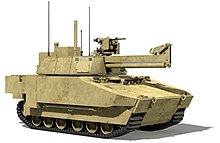
The XM1205 Field Recovery and Maintenance Vehicle (FRMV) was the recovery and maintenance system for employment within both the unit of action (UA) and unit of employment (UE) and contributes to sustaining and generating combat power to the Future Force structure. Each UA will have a small number of 2–3 man combat repair teams within the organic Forward Support Battalion (FSB) to perform field maintenance requirements beyond the capabilities of the crew chief/crew, more in-depth battle damage assessment repair (BDAR), and limited recovery operations. The recovery vehicle is designed to hold a crew of three with additional space for three additional recovered crew. The FRMV has a close combat support weapon (CCSW) and a 40 mm Mk 19 grenade launcher.
Infantry Carrier Vehicle
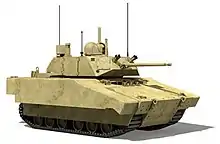
The XM1206 Infantry Carrier Vehicle (ICV) was a set of similar vehicles for transporting and supporting ground troops. The ICV featured a crew of 2 and space for 9 passengers. It is armed with a 30 mm MK44 cannon and a 7.62 mm machine gun.[12] The ICV consists of four platform versions: a Company Commander; a Platoon Leader; a Rifle Squad; and a Weapons Squad. All four platform versions have similar exteriors to prevent targeting of a specific ICV versions.
The Rifle Squad ICV and Weapons Squad ICV each deliver 9-person infantry squads to a close battle and support the squad by providing offensive and defensive fire, while carrying the majority of the soldiers' equipment. The ICV can move, shoot, communicate, detect threats, and protect crew and critical components under all climatic conditions, day or night.
The squad would have access to Army and joint fire delivery systems from external sources (e.g. the XM1203 Non-Line-of-Sight Cannon) to enhance the squad's range, precision, or quantity of fire. Networking with other components of the unit of action permits rapid identification of targets and improves situational awareness.
Medical vehicle
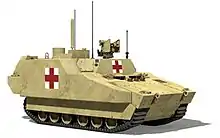
The XM1207/8 Medical Vehicle was designed to provide advanced trauma life support within 1 hour to critically injured soldiers. The Medical Vehicle serves as the primary medical system within the unit of action (UA) and will have two mission modules: Evacuation and Treatment. The time-sensitive nature of treating critically injured soldiers requires an immediately responsive force health protection system with an expedient field evacuation system. The XM1207 FCS Medical Vehicle-Evacuation (MV-E) vehicle allows trauma specialists, maneuvering with combat forces, to be closer to the casualty's point-of-injury and is used for casualty evacuation. The XM1208 Medical Vehicle-Treatment (MV-T) vehicle enhances the ability to provide Advanced Trauma Management (ATM)/Advanced Trauma Life Support (ATLS) treatments and procedures forward for more rapid casualty interventions and clearance of the battlespace. Both FCS Medical Vehicle mission modules will be capable of conducting medical procedures and treatments using installed networked telemedicine interfaces, Medical Communications for Combat Casualty Care and the Theater Medical Information Program (TMIP).
Command and control vehicle

The XM1209 Command and Control Vehicle (C2V) was to provide for information management of the integrated network of communications and sensor capability within the unit of action and provide the tools for commanders to synchronize their knowledge of combat power with the human dimension of leadership. It was to be located within the headquarters sections at each echelon of the unit of action down to the company level, and with its integrated command, control, and communications equipment suite, was to make command and control on the move possible.
The C2Vs were to contain all the interfaces required to enable the commander to leverage the power of the C4ISR network and provides the means for leaders at all levels to achieve information superiority and situational understanding. In addition, the C2Vs were meant to make possible the establishment, maintenance and distribution of a common operating picture fused from the friendly, enemy, civilian, weather and terrain situations while on the move. The crew was to use its integrated C4ISR suite (communication, computers and sensor systems) to receive, analyze and transmit tactical information via voice, video and data inside and outside the unit of action. The C2V was also planned to employ unmanned systems, such as unmanned aerial vehicles (UAVs) to enhance situational awareness throughout the unit of action.
See also
- Future Combat Systems
- Combat Vehicle Reconnaissance (tracked), an earlier, but similar, British concept
- Armored Systems Modernization (Cancelled due to the end of the Cold War)
- List of U.S. military vehicles by model number
References
- Manned Ground Vehicle overview Archived 2008-12-30 at the Wayback Machine. Boeing, 7 August 2008.
- Feickert, Andrew (5 May 2006). "The Army's Future Combat System (FCS): Background and Issues for Congress" (PDF). Retrieved 12 May 2017.
 This article incorporates text from this source, which is in the public domain.
This article incorporates text from this source, which is in the public domain. - "Army Working To Bring FCS, NLOS Cannon Efforts Together". Defense Daily. 22 October 2002. Archived from the original on 21 November 2018. Retrieved 14 May 2017.
- Erwin, Sandra (1 November 2005). "For Army's Future Combat Vehicles, Flying by C-130 No Longer Required". National Defense. Retrieved 14 May 2017.
- "Military Budget Reflects a Shift in U.S. Strategy" Archived 2017-06-28 at the Wayback Machine. New York Times, April 7, 2009. Retrieved on April 7, 2009.
- Cavallaro, Gina (June 11, 2009). "Panel to discuss new ground combat vehicle". Army Times. Retrieved June 14, 2009.
- McLeary, Paul. "U.S. Army Ground Vehicles Up and Down". Aviation Week, 8 May 2009.
- Jagirdar, Sarabjit (20 July 2009). "ARMY PARTIALLY TERMINATES FUTURE COMBAT SYSTEMS MANNED GROUND VEHICLE". US Fed News Service. Archived from the original on 16 November 2018. Retrieved 12 May 2017.
- "Contractors vie for lucrative vehicle work" Archived 2011-06-22 at the Wayback Machine. The Hill, August 5, 2010. Retrieved on August 21, 2010.
- Military Deputy for Budget Office of the Assistant Secretary of the Army (Financial Mgt and Comptroller) Lt. Gen. Edgar Stanton and Acting Director, Army Budget Office William Campbell May 07, 2009, News Transcript Archived 2009-05-30 at the Wayback Machine, U.S. Department of Defense, Office of the Assistant Secretary of Defense (Public Affairs).
- "GCV, Industry Day #1". Contracting.tacom.army.mil. Archived from the original on 2011-07-22. Retrieved 2011-03-31.
- Andrew Feickert (May 29, 2009). "The Army's Future Combat Systems Program" (PDF). Archived (PDF) from the original on June 29, 2011. Retrieved March 7, 2011.
- "Future Combat System Prototype Vehicles". GlobalSecurity.org. 30 September 2006. Archived from the original on 2 September 2009. Retrieved 6 May 2010.
- "The Army's Future Combat System (FCS): Background and Issues for Congress". DTIC.mil. 28 May 2009. Archived from the original on 4 June 2011. Retrieved 31 March 2011.
- Roosevelt, Ann (26 March 2008). "Advanced 120mm Gun For FCS Mounted Combat System In Safety Testing". Defense Daily. Archived from the original on 15 November 2018. Retrieved 12 May 2017.
- "M-109 Replacement Enters Production". Strategypage.com. 2007-07-24. Archived from the original on 2012-01-18. Retrieved 2011-03-31.
- "Artillery: M-109 Replacement Enters Production". Archived from the original on 2009-07-14. Retrieved 2009-07-06.
- C. Todd Lopez (2008-05-30). "First FCS Manned Vehicle to Make Public Debut". Army.mil. Archived from the original on 2010-04-12. Retrieved 2011-03-31.
- Nathan Hodge (11 February 2011). "Pentagon Loses War to Zap Airborne Laser from Budge". Wall Street Journal. Retrieved 1 October 2012.
- "FCS Whitepaper". U.S. Army, 11 April 2006.
- Non-Line-Of-Sight Mortar (NLOS-M). Globalsecurity.org
![]() This article incorporates public domain material from websites or documents of the United States Army.
This article incorporates public domain material from websites or documents of the United States Army.
External links
| Wikimedia Commons has media related to Future Combat Systems manned ground vehicles. |
- RL32888 "The Army's Future Combat System (FCS): Background and Issues for Congress". Congressional Research Service, May 29, 2009.
- Manned Ground Vehicles page on GlobalSecurity.org
- StrategyPage.com article
- First Round fired from 38-Calibre NLOS Cannon
- US Army FCS page with MGVs listed (archived version)
- US Army MCS page (archived version)
- US Army NLOS-C page (archived version)
- US Army C2V page (archived version)
- US Army ICV page (archived version)
- US Army FRMV page (archived version)
- US Army MV-T/MV-E page (archived version)
- US Army NLOS-M page (archived version)
- US Army RSV page (archived version)